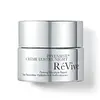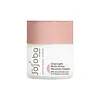What's inside
What's inside
 Key Ingredients
Key Ingredients

 Benefits
Benefits

 Concerns
Concerns

 Ingredients Side-by-side
Ingredients Side-by-side

Water
Skin ConditioningCaprylic/Capric Triglyceride
MaskingCyclopentasiloxane
EmollientPropanediol
SolventGlyceryl Stearate
EmollientPentylene Glycol
Skin ConditioningSqualane
EmollientJojoba Esters
EmollientDi-C12-15 Alkyl Fumarate
EmollientPEG-100 Stearate
Cetyl Acetate
EmollientGlycerin
HumectantCetyl Dimethicone
EmollientCandelilla/Jojoba/Rice Bran Polyglyceryl-3 Esters
EmulsifyingDimethicone Crosspolymer
Emulsion StabilisingCetyl Alcohol
EmollientDimethicone
EmollientCetearyl Alcohol
EmollientSodium Stearoyl Lactylate
EmulsifyingPhenoxyethanol
PreservativePolymethyl Methacrylate
Butylene Glycol
HumectantTocopheryl Acetate
AntioxidantGlucosamine Hcl
Mica
Cosmetic ColorantAcrylates/C10-30 Alkyl Acrylate Crosspolymer
Emulsion StabilisingPisum Sativum Extract
Skin ConditioningXanthan Gum
EmulsifyingAcetylated Lanolin Alcohol
EmollientBambusa Vulgaris Leaf/Stem Extract
HumectantCaprylyl Glycol
EmollientChlorphenesin
AntimicrobialSodium Hydroxide
BufferingParfum
MaskingDisodium EDTA
Carbomer
Emulsion StabilisingPolysorbate 20
EmulsifyingLeucojum Aestivum Bulb Extract
Skin ProtectingGlycosaminoglycans
EmollientPalmitoyl Oligopeptide
CleansingGlycine Soja Oil
EmollientSodium Oleate
CleansingPalmitoyl Hexapeptide-19
Skin ConditioningPalmitoyl Tetrapeptide-7
Skin ConditioningHydrogenated Lecithin
EmulsifyingDecapeptide-4
Skin ConditioningOligopeptide-24
Skin ConditioningCitronellol
PerfumingHexyl Cinnamal
PerfumingButylphenyl Methylpropional
PerfumingLimonene
PerfumingLinalool
PerfumingTitanium Dioxide
Cosmetic ColorantWater, Caprylic/Capric Triglyceride, Cyclopentasiloxane, Propanediol, Glyceryl Stearate, Pentylene Glycol, Squalane, Jojoba Esters, Di-C12-15 Alkyl Fumarate, PEG-100 Stearate, Cetyl Acetate, Glycerin, Cetyl Dimethicone, Candelilla/Jojoba/Rice Bran Polyglyceryl-3 Esters, Dimethicone Crosspolymer, Cetyl Alcohol, Dimethicone, Cetearyl Alcohol, Sodium Stearoyl Lactylate, Phenoxyethanol, Polymethyl Methacrylate, Butylene Glycol, Tocopheryl Acetate, Glucosamine Hcl, Mica, Acrylates/C10-30 Alkyl Acrylate Crosspolymer, Pisum Sativum Extract, Xanthan Gum, Acetylated Lanolin Alcohol, Bambusa Vulgaris Leaf/Stem Extract, Caprylyl Glycol, Chlorphenesin, Sodium Hydroxide, Parfum, Disodium EDTA, Carbomer, Polysorbate 20, Leucojum Aestivum Bulb Extract, Glycosaminoglycans, Palmitoyl Oligopeptide, Glycine Soja Oil, Sodium Oleate, Palmitoyl Hexapeptide-19, Palmitoyl Tetrapeptide-7, Hydrogenated Lecithin, Decapeptide-4, Oligopeptide-24, Citronellol, Hexyl Cinnamal, Butylphenyl Methylpropional, Limonene, Linalool, Titanium Dioxide
Water
Skin ConditioningSimmondsia Chinensis Seed Oil
EmollientJojoba Esters
EmollientLactococcus Ferment Lysate
Skin ConditioningHydrogenated Sunflower Seed Oil Glyceryl Esters
EmulsifyingHydrogenated Sunflower Seed Oil Polyglyceryl-3 Esters
EmulsifyingStearyl Alcohol
EmollientJojoba Alcohol
EmollientCetearyl Alcohol
EmollientButyrospermum Parkii Butter
Skin ConditioningSodium Stearoyl Lactylate
EmulsifyingPentylene Glycol
Skin ConditioningCetyl Alcohol
EmollientTremella Fuciformis Extract
HumectantHydrolyzed Tremella Fuciformis Sporocarp Extract
AntioxidantGlycerin
HumectantPropanediol
SolventHydroxyacetophenone
AntioxidantXanthan Gum
EmulsifyingCitrus Nobilis Oil
MaskingPelargonium Roseum Leaf Oil
PerfumingTocopherol
AntioxidantBenzyl Alcohol
PerfumingSalicylic Acid
MaskingSorbic Acid
PreservativeLimonene
PerfumingCitronellol
PerfumingGeraniol
PerfumingLinalool
PerfumingWater, Simmondsia Chinensis Seed Oil, Jojoba Esters, Lactococcus Ferment Lysate, Hydrogenated Sunflower Seed Oil Glyceryl Esters, Hydrogenated Sunflower Seed Oil Polyglyceryl-3 Esters, Stearyl Alcohol, Jojoba Alcohol, Cetearyl Alcohol, Butyrospermum Parkii Butter, Sodium Stearoyl Lactylate, Pentylene Glycol, Cetyl Alcohol, Tremella Fuciformis Extract, Hydrolyzed Tremella Fuciformis Sporocarp Extract, Glycerin, Propanediol, Hydroxyacetophenone, Xanthan Gum, Citrus Nobilis Oil, Pelargonium Roseum Leaf Oil, Tocopherol, Benzyl Alcohol, Salicylic Acid, Sorbic Acid, Limonene, Citronellol, Geraniol, Linalool
Ingredients Explained
These ingredients are found in both products.
Ingredients higher up in an ingredient list are typically present in a larger amount.
Cetearyl alcohol is a mixture of two fatty alcohols: cetyl alcohol and stearyl alcohol. It is mainly used as an emulsifier. Emulsifiers help prevent the separation of oils and products. Due to its composition, it can also be used to thicken a product or help create foam.
Cetearyl alcohol is an emollient. Emollients help soothe and hydrate the skin by trapping moisture.
Studies show Cetearyl alcohol is non-toxic and non-irritating. The FDA allows products labeled "alcohol-free" to have fatty alcohols.
This ingredient is usually derived from plant oils such as palm, vegetable, or coconut oils. There is debate on whether this ingredient will cause acne.
Due to the fatty acid base, this ingredient may not be Malassezia folliculitis safe.
Learn more about Cetearyl AlcoholCetyl Alcohol is a fatty alcohol. Fatty Alcohols are most often used as an emollient or to thicken a product.
Its main roles are:
Though it has "alcohol" in the name, it is not related to denatured alcohol or ethyl alcohol.
The FDA allows products labeled "alcohol-free" to have fatty alcohols.
Learn more about Cetyl AlcoholCitronellol is used to add fragrance/parfum to a product. It is often derived from plants such as roses. In fact, it can be found in many essential oils including geranium, lavender, neroli, and more. The scent of Citronellol is often described as "fresh, grassy, and citrus-like".
Since the Citronellol molecule is already unstable, Citronellol becomes irritating on the skin when exposed to air.
Citronellol is a modified terpene. Terpenes are unsaturated hydrocarbons found in plants. They make up the primary part of essential oils.
Citronellol is not able to be absorbed into deeper layers of the skin. It has low permeability,
Citronellol is also a natural insect repellent.
Learn more about CitronellolGlycerin is already naturally found in your skin. It helps moisturize and protect your skin.
A study from 2016 found glycerin to be more effective as a humectant than AHAs and hyaluronic acid.
As a humectant, it helps the skin stay hydrated by pulling moisture to your skin. The low molecular weight of glycerin allows it to pull moisture into the deeper layers of your skin.
Hydrated skin improves your skin barrier; Your skin barrier helps protect against irritants and bacteria.
Glycerin has also been found to have antimicrobial and antiviral properties. Due to these properties, glycerin is often used in wound and burn treatments.
In cosmetics, glycerin is usually derived from plants such as soybean or palm. However, it can also be sourced from animals, such as tallow or animal fat.
This ingredient is organic, colorless, odorless, and non-toxic.
Glycerin is the name for this ingredient in American English. British English uses Glycerol/Glycerine.
Learn more about GlycerinJojoba Esters is a wax created from Jojoba oil. It is an emollient and film-forming ingredient. In bead form, it is an exfoliator.
This ingredient has high oxidative stability, meaning it doesn't break down when exposed to oxygen.
Its similarity to our skin's natural oils makes it a great emollient. Emollients help soften and soothe our skin by creating a barrier on top. This barrier helps trap moisture in, keeping skin hydrated.
It is created using either the hydrogenation or transesterification processes on jojoba oil.
Learn more about Jojoba EstersLimonene is a fragrance that adds scent and taste to a formulation.
It's found in the peel oil of citrus fruits and other plants such as lavender and eucalyptus. The scent of limonene is generally described as "sweet citrus".
Limonene acts as an antioxidant, meaning it helps neutralize free radicals.
When exposed to air, oxidized limonene may sensitize the skin. Because of this, limonene is often avoided by people with sensitive skin.
The term 'fragrance' is not regulated in many countries. In many cases, it is up to the brand to define this term. For instance, many brands choose to label themselves as "fragrance-free" because they are not using synthetic fragrances. However, their products may still contain ingredients such as essential oils that are considered a fragrance.
Learn more about LimoneneLinalool is a fragrance and helps add scent to products. It's derived from common plants such as cinnamon, mint, citrus, and lavender.
Like Limonene, this ingredient oxidizes when exposed to air. Oxidized linalool can cause allergies and skin sensitivity.
This ingredient has a scent that is floral, spicy tropical, and citrus-like.
Learn more about LinaloolPentylene glycol is typically used within a product to thicken it. It also adds a smooth, soft, and moisturizing feel to the product. It is naturally found in plants such as sugar beets.
The hydrophilic trait of Pentylene Glycol makes it a humectant. As a humectant, Pentylene Glycol helps draw moisture from the air to your skin. This can help keep your skin hydrated.
This property also makes Pentylene Glycol a great texture enhancer. It can also help thicken or stabilize a product.
Pentylene Glycol also acts as a mild preservative and helps to keep a product microbe-free.
Some people may experience mild eye and skin irritation from Pentylene Glycol. We always recommend speaking with a professional about using this ingredient in your routine.
Pentylene Glycol has a low molecular weight and is part of the 1,2-glycol family.
Learn more about Pentylene GlycolPropanediol is an all-star ingredient. It softens, hydrates, and smooths the skin.
It’s often used to:
Propanediol is not likely to cause sensitivity and considered safe to use. It is derived from corn or petroleum with a clear color and no scent.
Learn more about PropanediolThis ingredient also goes by the name SSL. It is a non-toxic, biodegradable ingredient made from renewable sources.
SSL is typically used as a surfactant and emulsifier in skincare to stabilize water-based formulas and improve texture. It can be synthetic or animal-derived.
Water. It's the most common cosmetic ingredient of all. You'll usually see it at the top of ingredient lists, meaning that it makes up the largest part of the product.
So why is it so popular? Water most often acts as a solvent - this means that it helps dissolve other ingredients into the formulation.
You'll also recognize water as that liquid we all need to stay alive. If you see this, drink a glass of water. Stay hydrated!
Learn more about WaterXanthan gum is used as a stabilizer and thickener within cosmetic products. It helps give products a sticky, thick feeling - preventing them from being too runny.
On the technical side of things, xanthan gum is a polysaccharide - a combination consisting of multiple sugar molecules bonded together.
Xanthan gum is a pretty common and great ingredient. It is a natural, non-toxic, non-irritating ingredient that is also commonly used in food products.
Learn more about Xanthan Gum